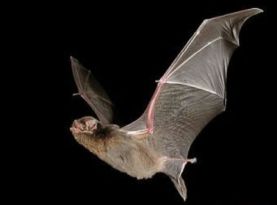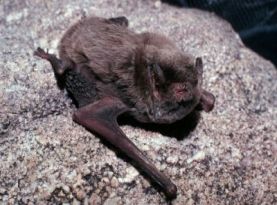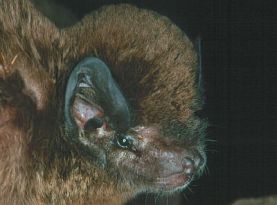Southern Bent-wing Bat - National Recovery Team
The Southern Bent-wing Bat (Miniopterus orianae bassanii) is considered Critically Endangered and only occurs in south-western Victoria extending into the south-east corner of South Australia.
Once numbering in the hundreds of thousands across southern Australia, the current population is estimated to comprise fewer than 45,000 mature individuals.
In 2019 a National Recovery Team was formed to prevent this species from becoming extinct.
Overview of the Southern Bent-wing Bat
The Southern Bent-wing Bat is one of three closely related but genetically and geographically distinct bats (Cardinal & Christidis 2000). There is evidence that these subspecies may warrant full-species recognition and a taxonomic revision is currently underway.
Southern Bent-wing Bat Miniopterus orianae bassanii - (southern subspecies), distributed in south-western Victoria extending into the south-east corner of South Australia.
Eastern Bent-wing Bat Miniopterus orianae oceanensis - (eastern subspecies), occurring near coastal eastern Australia from the northern tip of Queensland down the east coast including New South Wales and extending to central Victoria.
Northern Bent-wing Bat Miniopterus orianae orianae - (northern subspecies), found in the northern part of Western Australia and Northern Territory.
Source: Australian Faunal database (AFD 2019)
Identification
The Southern Bent-wing Bat has dark brown to reddish brown fur above, grey-brown fur underneath and pale brown areas of bare skin. Head and body length 52mm-58mm, forearm 45-49mm. It has a short muzzle, high crowned head, broad rounded ears and small eyes. It has a long wing length being nearly two and half times longer than the head and body. The second phalanx on the third finger of the wing is about four times the length of the first phalanx, giving the typical ‘bent-wing’ appearance (van Dyck et al. 2013).
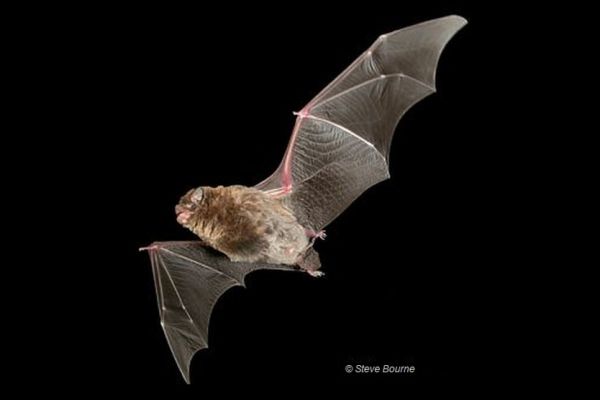
Identification caution
The Southern Bent-wing Bat is reliant on only two main caves for rearing young and selected caves for roosting, and is highly susceptible to human disturbance, including light and noise. Identification is best carried out by non-handling techniques and certainly not by entering known roost sites. A preferred method of identification is by recording and analysing call sequences.
Distribution of Southern Bent-wing Bat
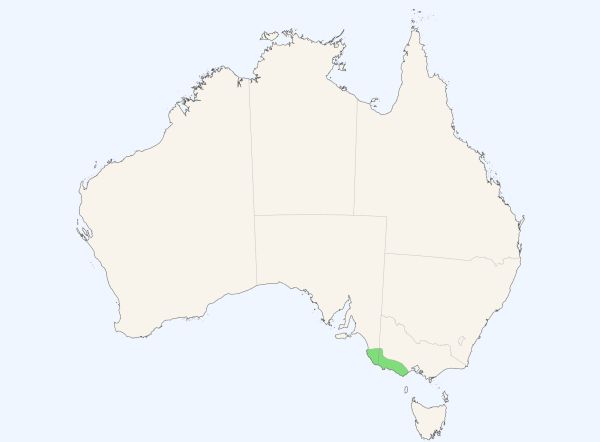
Ecology & Habitat
The Southern Bent-wing Bat can live up to 22 years (Lumsden and Gray 2001). Habitat preference is associated with the availability of foraging areas and proximity to suitable roosting caves. The Southern Bent-wing Bat roosts exclusively in caves or cave like structures.
Movement
Foraging areas include forested areas, agricultural land, vineyards, volcanic plains, wetlands and coastal vegetation. Southern Bent-wing Bats can forage over large distances, with current research showing individuals can fly at least 72 kilometres in just a few hours, and commute up to 150km in a night.
Foraging flights of the Southern Bent-wing Bat - ARI Fact Sheet
Breeding
Breeding takes place in late May and early June, however gestation is delayed through winter until August (Crichton et al. 1989). Southern Bent-wing Bats are dependent on maternity caves which retain warmth and humidity for development of the young. There are only two main maternity caves for the Southern Bent-wing Bat; a cave near Warrnambool, Victoria and the Naracoorte Bat Cave in south-eastern South Australia (Dwyer and Hamilton-Smith 1965). There is a third, smaller maternity site near Portland, Victoria. In Southern Bent-wing Bats, both males and females are found at maternity caves. By congregating en masse at Bat Cave, the bats can increase the temperature in the dome-like maternity chamber to up to 30 degrees Celsius (Baudinette et al. 1994). Females give birth to single furless pup in late November to December. By February to March the young are weaned and free flying. The same maternity caves are used each year.
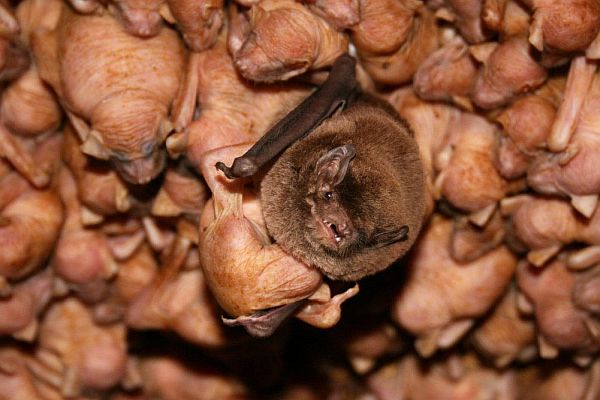
A mother Southern Bent-wing Bat, nursing her pup in the creche of furless young at Bat Cave. Photo: Steve Bourne.
Feeding
The Southern Bent-wing Bat is nocturnal and uses echolocation (emission of ultrasonic sounds) for navigation and feeding. Feeding is carried out during flight and prey is typically caught in the tail or wing membrane and transferred to the mouth whilst in flight. Diet consists of a range of night flying insects, particularly Lepidoptera (moths). Insectivorous bats play a major role as the nocturnal predator of night flying insects, many of which are considered agricultural pests.
Roosting and hibernation
On return to their roosting caves the bats cluster at preferred microclimates within the cave. During this time they carry out grooming and rest by lowering their body temperature to the ambient temperature and go into a torpor state for a period of hours. Over the winter months when insect activity is low and food is not readily available they go into a deeper hibernation and select the coolest caves and coolest part of the cave (Hall 1982). During this time their body temperature can be down to 20C, which limits the loss of body fats through winter (Speakman & Thomas 2003). They are particularly prone to disturbance when at rest as valuable reserves of body fat are consumed if disturbed.
Little is known about the winter and hibernation behaviour of Australian insectivorous bats and more information is urgently needed to better understand their vulnerability to white-nose syndrome, a disease that impacts bats during hibernation (Turbill and Welbergen 2020). The disease has caused devastating declines in bat populations in North America. A risk assessment has found that it is almost certain that the fungus causing white-nose syndrome will be inadvertently introduced to Australia in the coming years (Holz et al. 2019). The Southern Bent-wing Bat has been identified as the Australian species most at risk due to several reasons, including (Holz et al. 2019) :
- the entire Southern Bent-wing Bat range occurs within the optimal average growth temperatures for the fungus causing white-nose syndrome
- the Southern Bent-wing Bat clusters in caves in large numbers which can facilitate spread
- the Southern Bent-wing Bat is already critically endangered, so further increases in mortality are likely to affect long-term viability
Threats
There has been a severe decline in the Southern Bent-wing Bat. The total population size was estimated to be approximately 200,000 several decades ago, now it is down to less than 45,000 mature individuals across its entire range.
The severity of the declines in the two populations, and the reliance on just two main maternity caves led to the Southern Bent-wing Bat being listed as threatened nationally and in the states of Victoria and South Australia. In 2007 it was listed as Critically Endangered in 2007 under the Commonwealth Environment Protection and Biodiversity Conservation Act 1999.
A range of threats have been identified as potentially impacting the Southern Bent-wing Bat, including (DELWP 2020):
- loss and modification of foraging and roosting habitat
- climate change and drought
- human disturbance
- disease, including the risk of white-nose syndrome
- wind farm development
- pesticides/toxins
- introduced predators
Disease Surveillance
The Southern Bent-wing Bat National Recovery Team, and other bat and wildlife health experts, are concerned about disease as a potential contributor to future declines of the Southern Bent-wing Bat, including, but not limited to, the devastating fungal disease White Nose Syndrome (see also Wildlife Health Australia Fact Sheet), which is currently thought to be exotic to Australia. Engaging in disease surveillance means being on the constant lookout for disease outbreaks, through examining live and/or dead bats, testing for diseases and determining cause of death where possible. Early detection gives us the best chance at managing such outbreaks before they have significant or irreversible impacts on populations. Have you noticed any unusual bat activity, multiple mortalities, or bats with possible signs of disease? Or are you a vet, caver or cave manager? Please see the following fact sheets for more information about what you should be on the lookout for, and what to do if you notice something:
Recovery Team
The Southern Bent-wing Bat National Recovery Team was formed in 2019. The primary role of the Recovery Team is to coordinate the implementation and ongoing review of the National Recovery Plan for the Southern Bent-wing Bat.
The long-term recovery objective is to ensure that the Southern Bent-wing Bat can survive, flourish and retain its potential for evolutionary development in the wild. The specific objectives of the recovery plan are to:
- Develop techniques to accurately estimate the population size at the maternity sites and undertake regular assessments of population numbers to thoroughly document population trends.
- Determine the main cause/s of the recent decline in numbers of Southern Bent-wing Bats, and develop targeted, rapid management responses.
- Protect the maternity sites and other key non-breeding sites.
- Protect and enhance foraging habitat around the maternity sites and key non-breeding sites.
- Clarify the taxonomic status, distribution and population structure of the Southern Bent-wing Bat.
- Compile and maintain databases to aid in the management of the subspecies.
- Establish a long-term monitoring program for the Southern Bent-wing Bat.
- Facilitate and promote community interest, understanding and participation.
- Provide direction and guidance to the recovery of the Southern Bent-wing Bat and review the success of this Recovery Plan.
Southern Bent-wing Bat National Recovery Team Annual Progress Report 2021
Southern Bent-wing Bat National Recovery Team Annual Progress Report 2022
Southern Bent-wing Bat National Recovery Team Progress Report 2024
Members
The Southern Bent-wing Bat National Recovery Team is made up of members from:
- Arthur Rylah Institute for Environmental Research
- Australian Speleological Federation
- Department of Agriculture, Fisheries and Forestry (Australian Government)
- Department of Environment and Water (South Australia)
- Department of Energy, Environment and Climate Action (Victoria) (Victoria)
- South Australian Museum
- Limestone Coast Landscape Board
- Naracoorte Caves National Park
- Nature Glenelg Trust
- The University of Adelaide
- The University of Melbourne
- Wildlife Health Australia
- Zoos Victoria - Fighting Extinction
- Glenelg Hopkins Catchment Management Authority
References
AFD (2019) Australian Faunal Directory, Miniopterus orianae - check list, Department of Environment and Energy, Australia. Accessed 13 November 2019.
Baudinette, R., Wells, R., Sanderson, K., and Clark, B. (1994). Microclimatic conditions in maternity caves of the bent-wing bat, Miniopterus schreibersii: an attempted restoration of a former maternity site. Wildlife Research 21, 607–619. doi:10.1071/WR9940607
Cardinal, B. R., and Christidis, L. (2000). Mitochondrial DNA and morphology reveal three geographically distinct lineages of the large bentwing bat (Miniopterus schreibersii) in Australia. Australian Journal of Zoology 48, 1. doi:10.1071/ZO99067
Crichton, E. G., Seamark, R. F., and Krutzsch, P. H. (1989). The status of the corpus luteum during pregnancy in Miniopterus schreibersii (Chiroptera: Vespertilionidae) with emphasis on its role in developmental delay. Cell and Tissue Research 258. doi:10.1007/BF00223157
DELWP (2020). National Recovery Plan for the Southern Bent-wing Bat Miniopterus orianae bassanii. Victorian Government, Melbourne.
Dwyer, P. D., and Hamilton-Smith, E. (1965). Breeding caves and maternity colonies of the bent-winged bat in south-eastern Australia. Helictite 4, 3–21.
Hall, L. S. (1982). The effect of cave microclimate on winter roosting behaviour in the bat, Miniopterus schreibersii blepotis. Austral Ecology 7, 129–136. doi:10.1111/j.1442-9993.1982.tb01586.x
Holz, P., Hufschmid, J., Boardman, W. S. J., Cassey, P., Firestone, S., Lumsden, L. F., Prowse, T. A. A., Reardon, T., and Stevenson, M. (2019b). Does the fungus causing white-nose syndrome pose a significant risk to Australian bats? Wildlife Research 46, 657. doi:10.1071/WR18194
Lumsden, L., and Gray, P. (2001). Longevity record for a Southern Bent-wing Bat Miniopterus schreibersii bassanii. The Australasian Bat Society Newsletter 16, 43-44.
Speakman, J. R., and Thomas, D.W. (2003) Physiological Ecology and Energetics of Bats, In; Bat Ecology, pp 430-489, (Eds). Kunz, T.H. & Fenton, M.B., The University of Chicago Press, Chicago and London.
Turbill, C., and Welbergen, J. A. (2020). Anticipating white-nose syndrome in the Southern Hemisphere: Widespread conditions favourable to Pseudogymnoascus destructans pose a serious risk to Australia’s bat fauna: White-nose syndrome risk to Australian bats. Austral Ecology 45, 89–96. doi:10.1111/aec.12832
Van Dyck S., Gynther, I. and Baker, A. (2013). Field companion to the Mammals of Australia, Sydney, NSW: New Holland.
Other resources
- Southern Bent-wing Bat National Recovery Team Annual Progress Report 2021
- National Recovery Plan for the Southern Bent-wing Bat
- National Conservation Advice
- SWIFFT video conference notes – Insectivorous bats July 2012.
- Zoos Victoria Fighting Extinction - Southern Bent-wing Bat
- Public fact sheet for reporting disease
- Fact sheet for veterinarians
- Fact sheet for cavers and cave managers
- Fact sheet - Foraging flights of the Southern Bent-wing Bat


